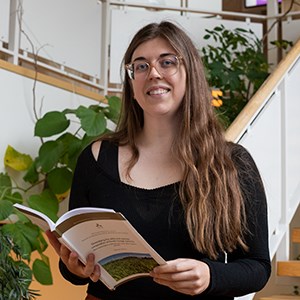Contact
Brooke Micke
SITES manager at the Department of Crop Production Ecology; Crop production science
Telephone: +46732689295
E-mail: brooke.micke@slu.se

On Friday, Brooke Micke will defend her doctoral thesis, which contains innovative ideas for sustainable leys and animal feed production.
Brooke Micke is studying how to introduce more diversity into forage production. This involves incorporating more plant species into mixed leys where farmers intercrop grasses and legumes, as well as finding new applications for the forage harvest.
Tomorrow is the day of her dissertation. Brooke Micke will defend her doctoral thesis titled "Diversifying the utility and species composition of Nordic forage systems: new fractionation methods and novel legume species."
Brooke Micke is from the USA, she studied botany and taxonomy before becoming a PhD student.
– At that time I had noticed a gap between botany and agricultural science. As a doctoral student, I have been able to bridge these two areas, which is very exciting, says Brooke Micke.
There are nearly 20,000 different legume species in nature, but humans cultivate only 65 of them. Red clover is the dominant legume in leys, offering good protein quality and high yields in the first two years after sowing. However, there are some issues; red clover is susceptible to some severe diseases, and the crop often declines after two years. At the same time, there are many potential alternative legumes in nature, looking at crop relatives from a botanical perspective. Increasing biodiversity in our agricultural systems is something Brooke Micke views as crucial in the long run.
– The native wild species in the Nordic region are adapted to withstand various stress factors in this environment. I have conducted a botanical survey and identified seven different legume species that exhibit promising characteristics for crop production in agriculture. One advantage of these species is that they flower early compared to red clover, which is beneficial for pollinating insects early in the season," says Brooke Micke.
The species are Anthyllis vulneraria, Astragalus alpinus, Lathyrus japonicus, Lathyrus palustris, Lathyrus pratensis, Vicia cracca and Vicia sepium.
Brooke Micke has explored various ways to separate fractions of the forage harvest to obtain a protein-rich fraction and a fiber-rich fraction. A product with high protein content and minimal fiber from leys could be interesting to use to feed monogastric farm animals like pigs and chickens.
– I have found that press juicing produced fractions with better nutrient composition for the intended purpose than leaf stripping of red clover and alsike clover.
She thinks that the two different aspects of increasing diversity in forage cultivation, 1) expanding the species composition in mixed leys and 2) developing methods that enable more uses for forage harvests, are equally important.
– When it comes to the project of exploring the botanical resources of wild plants for future agricultural production, I had the opportunity to develop my own idea that I had from the beginning. It was fun, and I believe it's quite unusual for a doctoral student to have such freedom in choosing the direction of their research studies, she says.
SITES manager at the Department of Crop Production Ecology; Crop production science
Telephone: +46732689295
E-mail: brooke.micke@slu.se